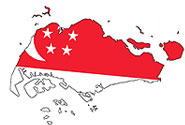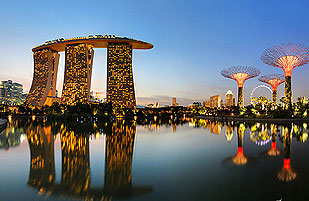 Total Area
Total Area
697.1 sq km (269 sq miles)
 CAPITAL
CAPITAL
Singapore City State
 Population
Population
4.6 million (official figure 2007)
 Climate
Climate
Warm and fairly humid summer temperatures throughout the year approximately 30ºC/86ºF during the day and 23ºC/74ºF in the evening). There is no distinct wet/dry season. Most rain falls during the northeast monsoon (November to January) and showers are usually sudden and heavy.
Singapore Overview
 Singapore comprising 63 islets encircling the main island is a land of natural and man made beauties. A popular centre of commerce, one of the world's most significant oil refining and distribution centers and the hub of tourism, Singapore in the last 150 years has proved to be a leader in all respects.
Singapore comprising 63 islets encircling the main island is a land of natural and man made beauties. A popular centre of commerce, one of the world's most significant oil refining and distribution centers and the hub of tourism, Singapore in the last 150 years has proved to be a leader in all respects.
A country with a fusion of the traditional and the modern, Singapore's dynamics is unique and incomparable. A melting pot of cultures, Singapore's population includes Malays, Chinese, Indians, Filipinos, Thai and ethnic groups. The different ethnic quarters in Singapore like Little India, Chinatown, Kampong Glam and Geylang Serai further display the variety and assortment of cultures and ethnicity in Singapore.
Singapore is a magnificent land of innumerous skyscrapers, state-of-the-art architecture, delicious cuisine, breathtaking locations, many museums, temples and above all extremely warm and amiable people.
History
History of Singapore reminds one of the antecedents of this great city-state. Javanese inscriptions dating back to the 14th century refer to Singapore as Tumasik (meaning sea).
The present name has roots from South India when Rajendra the ruler of South Indian Chola Kingdom called it Singapura (Lion City).
During the 16- 19th century Europeans ruled Singapore due to its strategic position in South Asia. The History of Singapore has seen the Portuguese who made Malacca their port and later the Dutch and the Eat India Company.
One of the important date that proved to be a landmark in Singapore history was the year of 1818 when Sir Thomas Stamford the made the island of Singapore his new port. Later he was able to negotiate with the local rulers - Sultan of Johor and thereby concluding a treaty on 6th February 1819 to make Singapore a British Trading post.
By 19th century Singapore due to migrations from different parts of Asia had become a multi- cultural society comprising of Chinese, Malayans and Indians. The ensuing cultural unification is reflected on the architecture, language, and cuisine thus becoming the heritage of Singapore. One also finds various reforms taking place during the 19th century. History of Singapore also reveals the affect of World War II when the Japanese army invaded in 1941 and later withdrew. By 1950's one finds the changes and in 1955 the internal self-Govt. was established. In 1963 due to changing circumstances one finds the endeavor to the unification of Singapore with Malaysia but due to racial tensions it ended in a fiasco. It was on 9th August the expulsion of Singapore from the unification led to the birth of Republic of Singapore
Singapore history showcases that due to unique geographical position and coupled with reforms the city - state of Singapore has been able to carve a niche for itself in the Asia
Attractions
Singapore Tourist Attractions include some of the most picturesque locations, beautiful architecture, very interesting ethnic quarters, different places of worship, many wildlife sanctuaries, the fascinating SingaporeRiver, the fabulous parks and gardens and the state-of-the-art museums.
Singapore Tourist Attractions
The Ethnic Quarters of Singapore is a famous tourist attraction of Singapore as it highlights the heterogeneity and the diversity of culture in Singapore. The ethnic quarters include Little India, Chinatown, Geylang Serai and Kampong Glam.
The wildlife sanctuaries of Singapore are an important tourist attraction. The Singapore Zoo is famous for the orang utan and small-clawed otter and reticulated python. The JurongBirdPark is another favorite tourist location in Singapore. It is famous for the 600 different species of animals. The Underwater World located on Sentosa is home to the different underwater animals. The ButterflyPark and InsectKingdom is unique to Singapore.
Some of the museums of Singapore are the AsianCivilizationsMuseum, Changi Chapel and Museum, the Chinatown Heritage Centre and the MalayHeritageCenter.
Singapore is popular for its magnificent places of worship like the Abdul Gaffoor Mosque, Armenian Church, CentralSikhTemple, Hajjah Fatimah Mosque and the Jamae Chulia Mosque.
Those interested in water sports, the SingaporeRiver will seem your ultimate tourist destination in Singapore. The Robertson Quay, the Clarke Quay and the Boat Quay offer different and very unique landscapes.
Despite rapid industrialisation, the majority of Singaporeans celebrate the major festivals associated with their respective religions. The variety of religions found in Singapore is a direct reflection of the diversity of races living there. The Chinese are predominantly followers of Buddhism and Shenism (deity worship), though some are Christians. Malays are overwhelmingly Muslims and most of Singapore's Indians are Hindus; there is, however, a sizeable proportion of Muslims and Sikhs amongst the Indian population.
The four official languages of Singapore are Mandarin, Malay, Tamil and English. English is widespread and is the language which unites the various ethnic groups. Children are taught in English at school but also learn their mother tongue to make sure they don't lose contact with their traditions. The only communication problem English-speakers are likely to have in Singapore is with older Singaporeans who did not learn English at school, though trying to understand the unique patois called Singlish - which uses a clipped form of English mixed with Malay and Hokkien words - can be taxing. The use of Malay is mostly restricted to the Malay community. Chinese dialects, such as Hokkien, Teochew, Cantonese, Hainanese and Hakka, are still widely spoken, especially among the older Chinese, but the government's long-standing campaign to promote Mandarin, the main non-dialectal Chinese language, has been very successful and increasing numbers of Chinese now speak Mandarin at home. Tamil is the main Indian language, though Malayalam and Hindi are also spoken.
Older Singaporeans are keen on Chinese opera, which is a colourful mixture of dialogue, music, song and dance. It is an ancient form of theatre which reached the peak of its popularity during the Ming Dynasty from the 14th to 17th centuries. The acting is heavy and stylised, and the music cacophonous to most Western ears. Street performances are held during important festivals such as Chinese New Year. The Lion Dance is a spectacular, acrobatic dance usually performed during Chinese festivals. Other performing arts include Malay and Indian dances; liberalisation has also meant a noticeable increase in alternative theatre, but the mainstay of Singaporean culture must be shopping.



